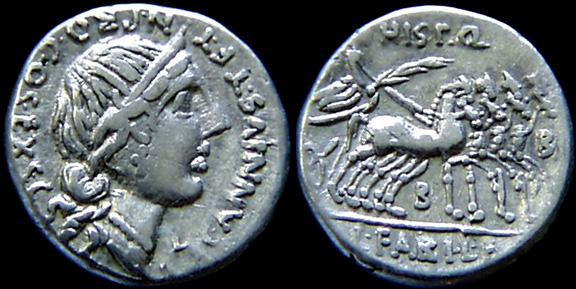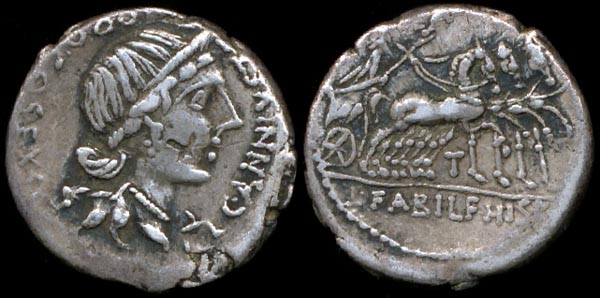








Designed by Nigel G Wilcox





The Paragon Of Metal Detecting
& Archaeology
& Archaeology
Powered By Sispro1
Denarius
For Reference ONLY
Everything For The Detectorist
*
Roman Denarius BC - Currency Numismatics,
Denarius



C. Annius T.f. Tn. Luscus & L. Fabius L.f. Hispaniensis 82-81 BC
In the Roman Republic, moneyers were called tresviri aere argento auro flando feriundo, literally "three men for striking (and) casting bronze, silver (and) copper (coins)". This was a board of the college of the vigintisexviri . The title was sometimes abbreviated III. VIR. AAAFF. or even III. VIR. A.P.F. (tresviri ad pecuniam feriundum) on the coinage itself. These men were also known collectively known as the tresviri monetales or sometimes, less correctly, as the triumviri monetales. The singular is triumvir monetalis. In English, they are also sometimes called mint magistrates.
In the early times of the Republic, there are few records of any officers who were charged with the superintendence of the mint , and there is little respecting the introduction of such officers apart from a very vague statement from Pomponius. (de Orig. Jur. Dig. 1. tit. 2. § 30.) It was thought by Niebuhr (Hist, of Rome, iii. p. 646) that they were introduced at the time when the Romans first began to coin silver, in 269 BC, but modern authors consider this too precise a reading of Pomponius. It is known that a college of three was in existence ca 150 BC .. A fourth magistrate was added by Julius Caesar in 44 BC during a time when the mint output was particularly large (in preparation for a war against Parthia).
These magistrates were responsible for the production of the Roman coinage. They were not simple mint workers (monetarii), they were officials who controlled the process, including the design on the coins themselves. Membership in the vigintisexvirate was the first step on the cursus honorum, the age when the post could be held appears to have been approximately 30, and there is some evidence that the position was appointed rather than elected.
Some coins appear to have been special issues bearing the legend S C or EX S. C. (ex senatus consulto). Some of these special issues do not bear the signature of a triumvir monetalis, but the inscription CVR. X. FL. i. e. curator denariorum flandorum, or are signed by praetors (P), aediles (CVR AED), or quaestors (Q).
The magistrate's control of the legend on the coinage lent itself to the production of coins containing political messages. This Republican denarius of the moneyers, C. Annius T.f. T.n. Luscus and L. Fabius L.f. Hispaniensis, struck at Rome, 82-81 BC. Coin incomplete. Roman Republic Reign/Issue Authority: Mint: Rome, Moneyer: C. Annius T.f. T.n. Luscus and L. Fabius L.f. Hispaniensis.
Issue Date: 82 - 81 BC Metal: Silver, Diameter (mm): Approx 18mm
Obverse Description: Diademed and draped female bust right, scales before, lituus below, caduceus behind,
Obverse Legend: C ANNI T F T N PRO COS EX S C
Reverse: Victory in quadriga right, holding palm, Q above, L FABI L F HISP in exergue
In the Roman Republic, moneyers were called tresviri aere argento auro flando feriundo, literally "three men for striking (and) casting bronze, silver (and) copper (coins)". This was a board of the college of the vigintisexviri . The title was sometimes abbreviated III. VIR. AAAFF. or even III. VIR. A.P.F. (tresviri ad pecuniam feriundum) on the coinage itself. These men were also known collectively known as the tresviri monetales or sometimes, less correctly, as the triumviri monetales. The singular is triumvir monetalis. In English, they are also sometimes called mint magistrates.
In the early times of the Republic, there are few records of any officers who were charged with the superintendence of the mint , and there is little respecting the introduction of such officers apart from a very vague statement from Pomponius. (de Orig. Jur. Dig. 1. tit. 2. § 30.) It was thought by Niebuhr (Hist, of Rome, iii. p. 646) that they were introduced at the time when the Romans first began to coin silver, in 269 BC, but modern authors consider this too precise a reading of Pomponius. It is known that a college of three was in existence ca 150 BC .. A fourth magistrate was added by Julius Caesar in 44 BC during a time when the mint output was particularly large (in preparation for a war against Parthia).
These magistrates were responsible for the production of the Roman coinage. They were not simple mint workers (monetarii), they were officials who controlled the process, including the design on the coins themselves. Membership in the vigintisexvirate was the first step on the cursus honorum, the age when the post could be held appears to have been approximately 30, and there is some evidence that the position was appointed rather than elected.
Some coins appear to have been special issues bearing the legend S C or EX S. C. (ex senatus consulto). Some of these special issues do not bear the signature of a triumvir monetalis, but the inscription CVR. X. FL. i. e. curator denariorum flandorum, or are signed by praetors (P), aediles (CVR AED), or quaestors (Q).
The magistrate's control of the legend on the coinage lent itself to the production of coins containing political messages. This Republican denarius of the moneyers, C. Annius T.f. T.n. Luscus and L. Fabius L.f. Hispaniensis, struck at Rome, 82-81 BC. Coin incomplete. Roman Republic Reign/Issue Authority: Mint: Rome, Moneyer: C. Annius T.f. T.n. Luscus and L. Fabius L.f. Hispaniensis.
Issue Date: 82 - 81 BC Metal: Silver, Diameter (mm): Approx 18mm
Obverse Description: Diademed and draped female bust right, scales before, lituus below, caduceus behind,
Obverse Legend: C ANNI T F T N PRO COS EX S C
Reverse: Victory in quadriga right, holding palm, Q above, L FABI L F HISP in exergue
Roman Emperor Timeline
Roman Menu
Copyright © All Rights Reserved by Nigel G Wilcox · · E-Mail: ngwilcox100@gmail.com
Pages
Main Coin Menu

VIEW ALL
Member NCMD
R.B.C. Menu
Information Data

























